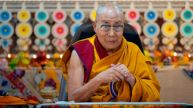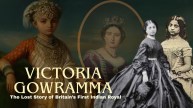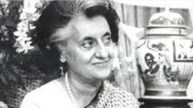Radhikaraje Gaekwad, the Maharani of Baroda, who lives in a ₹25,000 crore gold palace, actively preserves heritage and passionately revives traditional textiles. People admire her for her impeccable sense of style and refined fashion choices. Widely admired for blending heritage aesthetics with innovative saree designs, she drew attention at Sabyasachi Mukherjee’s event in January. Her saree- an exquisite piece woven with real gold zari- was a showstopper, believed to be one of the oldest treasures from the Gaekwad royal family’s collection.
She’s currently the talk of the town for wearing another heritage-rich saree- a stunning blend of Indian and Bangladeshi craftsmanship, woven by artisans from authentic village communities, making her radiate with effortless grace. Draped in a soft, whisper-light Dhakai Jamdani saree, the Maharani, regarded as one of the most progressive royals of India, was honouring a shared legacy that connects India and Bangladesh beyond politics and geography.
She shared the elegant look on Instagram. She Posted: “There is one aspect of the shared legacy of India and Bangladesh that continues to weave the fabric of myth, nostalgia, pride and camaraderie, enough to dissolve degrees of differences and borders,” the Maharani penned as she introduced her followers to one of most sophisticated textiles of all times – the Dhakai Jamdani.
View this post on Instagram
---Advertisement---
Here’s What She Shared On Instagram – About ‘Dhakai Jamdani’
“The credit for this diplomatic feat goes to the simple weavers in remote villages of Bangladesh in Narayanganj and Sonargaon. Who bent over their handlooms produce one of most sophisticated textiles of all times – the Dhakai Jamdani.”
‘Dhakai Jamdani’
The Dhakai Jamdani saree is famous for its delicate craftsmanship. Its legendary quality comes from the flowing waters and rich soil of Bangladesh’s Sonargaon river port. Weavers crafted the fabric so finely that people could pass it through a ring or even use it to cover an elephant. However, over time, society withdrew its support, and artisans gradually lost the skills needed to make these sarees. As a result, only a few pieces remain, while many stories of their beauty live on.
The Dhakai saree created by Colorwaves Bee for Radhikaraje Gaekwad is based on a 150-year-old design called ‘Angurlata’. People recognise the design for its unique cornucopian grapevine motifs. The Victoria and Albert Museum in England preserves the original version of this saree. Artisans likely wove it in 1875, and officials brought it to England from the Indian Museum in 1879. Gaekwad had the rare privilege of seeing a similar saree at the Bengal textile exhibition in Kolkata, organised by Darshan Shah.
Artisans made this revival saree from 100×100 count pure cotton threads, and they took about 9–10 days to dye the threads and set up the warp. The actual weaving, requiring two artisans working 11-12 hours daily, took approximately 49-50 days, roughly two months in total to complete.
Samarjitsinh Ranjitsinh Gaekwad- Radhikaraje Gaekwad’s husband
Radhikaraje Gaekwad’s husband, Samarjitsinh Ranjitsinh Gaekwad, is a cricket administrator and a former cricketer who has represented his state in the Ranji Trophy. As for his royal connections, the Gaekwad family has ruled Baroda since the early 18th century. Samarjitsinh succeeded his father, Maharaja Ranjitsinh Pratapsinh Gaekwad, to the throne after his father’s passing. In 2012, he was officially crowned Maharaja at the Lakshmii Vilas Palace. Samarjitsinh Gaekwad received the palace along with a massive Gaekwad family fortune in a 2013 settlement, and has since been living there with his Radhikaraje Gaekwad, and other family members.












